
A pencil skirt is a slim-fitting skirt with a straight, narrow cut. Generally the hem falls to, or is just below, the knee and is tailored for a close fit. It is named for its shape: long and slim like a pencil. [1] [2]

A pencil skirt is a slim-fitting skirt with a straight, narrow cut. Generally the hem falls to, or is just below, the knee and is tailored for a close fit. It is named for its shape: long and slim like a pencil. [1] [2]

The pencil skirt may be worn either as a separate piece of clothing or as part of a suit. A pencil skirt usually has a vent at the back, or less commonly at the sides, since its slim, narrow shape can otherwise restrict the movement of the wearer. Sometimes a kick pleat, which exposes less skin, is used instead of a vent. Pencil skirts made from stretchy knitted fabrics do not normally need vents or pleats.
Typical shoes for wearing with a pencil skirt are pumps, or high heels, with sheer stockings or tights. Back-seamed hosiery recalls the classic pencil-skirt era of the 1950s. Pencil skirts can also be worn with flats for a more casual, youthful appearance that echoes the 1960s. Pencil skirts and loafers are classic preppy wear.[ citation needed ]

Narrow-fitting skirts have a long history in Western fashion. The predecessor to the pencil skirt is the hobble skirt, a pre–World War I fad inspired by the Ballets Russes. This full-length skirt with a narrow hem seriously impeded walking.
The French designer Christian Dior introduced the classic modern pencil skirt in his 1954 Autumn Winter collection. [3]
Along with the miniskirt, the pencil skirt quickly became very popular, particularly for office wear. This success was due to women's desire for new fashions in the wake of Second World War and Cold War rationing, coupled with the austere economic climate, when fabrics were expensive.

There are typically two types of clothing worn in Japan: traditional clothing known as Japanese clothing, including the national dress of Japan, the kimono, and Western clothing, which encompasses all else not recognised as either national dress or the dress of another country.
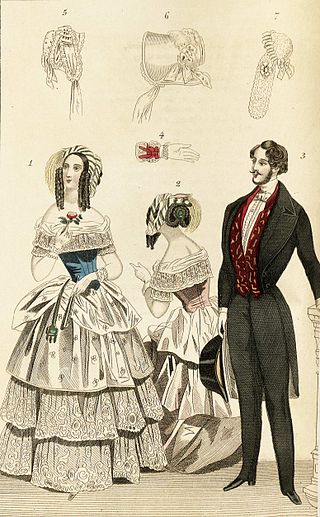
Victorian fashion consists of the various fashions and trends in British culture that emerged and developed in the United Kingdom and the British Empire throughout the Victorian era, roughly from the 1830s through the 1890s. The period saw many changes in fashion, including changes in styles, fashion technology and the methods of distribution. Various movement in architecture, literature, and the decorative and visual arts as well as a changing perception of gender roles also influenced fashion.
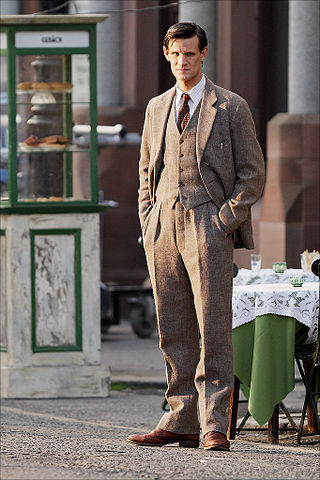
A suit, also called a lounge suit, business suit, dress suit, or formal suit is a set of clothes comprising a suit jacket and trousers of identical textiles generally worn with a collared dress shirt, necktie, and dress shoes. A skirt suit is similar, but with a matching skirt instead of trousers. It is currently considered semi-formal wear or business wear in contemporary Western dress codes, however when the suit was originally developed it was considered an informal or more casual option compared to the prevailing clothing standards of aristocrats and businessmen. The lounge suit originated in 19th-century Britain as sportswear and British country clothing, which is why it was seen as more casual than citywear at that time, with the roots of the suit coming from early modern Western Europe formal court or military clothes. After replacing the black frock coat in the early 20th century as regular daywear, a sober one-coloured suit became known as a lounge suit.

A blouse is a loose-fitting upper garment that may be worn by workmen, peasants, artists, women, and children. It is typically gathered at the waist or hips so that it hangs loosely ("blouses") over the wearer's body. Today, the word most commonly refers to a girl's or woman's dress shirt, although there is considerable confusion between a true blouse and a women's shirt. It can also refer to a man's shirt if it is a loose-fitting style, though it rarely is. Traditionally, the term has been used to refer to a shirt which blouses out or has an unmistakably feminine appearance, although even many "standard" shirts today have a somewhat blousy fit, and the numbers of men wearing such shirts may match that of women wearing actual blouses.

Suspenders, or braces are fabric or leather straps worn over the shoulders to hold up skirts or trousers. The straps may be elasticated, either entirely or only at attachment ends, and most straps are of woven cloth forming an X or Y shape at the back. Suspenders are typically attached to skirts and trousers with clips or buttons using leather tabs at the ends.

1870s fashion in European and European-influenced clothing is characterized by a gradual return to a narrow silhouette after the full-skirted fashions of the 1850s and 1860s.

A hobble skirt was a skirt with a narrow enough hem to significantly impede the wearer's stride. It was called a "hobble skirt" because it seemed to hobble any woman as she walked. Hobble skirts were a short-lived fashion trend that peaked between 1908 and 1914.

A ball gown, ballgown or gown is a type of evening gown worn to a ball or a formal event. Most versions are cut off the shoulder with a low décolletage, exposed arms, and long bouffant styled skirts. Such gowns are typically worn with opera-length white gloves, vintage jewelry or couture, and a stole, cape, or cloak in lieu of a coat. Where "state decorations" are to be worn, they are on a bow pinned to the chest, and married women wear a tiara if they have one. Although synthetic fabrics are now sometimes used, the most common fabrics are satin, silk, taffeta and velvet with trimmings of lace, pearls, sequins, embroidery, ruffles, ribbons, rosettes and ruching.
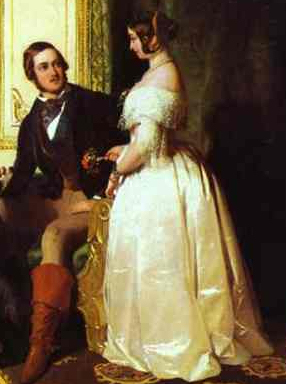
1840s fashion in European and European-influenced clothing is characterized by a narrow, natural shoulder line following the exaggerated puffed sleeves of the later 1820s and 1830s. The narrower shoulder was accompanied by a lower waistline for both men and women.
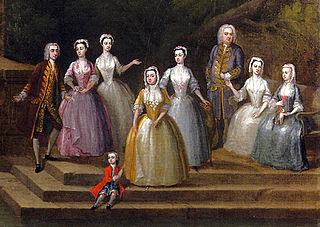
Fashion in the period 1700–1750 in European and European-influenced countries is characterized by a widening silhouette for both men and women following the tall, narrow look of the 1680s and 90s. This era is defined as late Baroque/Rococo style. The new fashion trends introduced during this era had a greater impact on society, affecting not only royalty and aristocrats, but also middle and even lower classes. Clothing during this time can be characterized by soft pastels, light, airy, and asymmetrical designs, and playful styles. Wigs remained essential for men and women of substance, and were often white; natural hair was powdered to achieve the fashionable look. The costume of the eighteenth century, if lacking in the refinement and grace of earlier times, was distinctly quaint and picturesque.
A pleat is a type of fold formed by doubling fabric back upon itself and securing it in place. It is commonly used in clothing and upholstery to gather a wide piece of fabric to a narrower circumference.

Fashion in the years following World War II is characterized by the resurgence of haute couture after the austerity of the war years. Square shoulders and short skirts were replaced by the soft femininity of Christian Dior's "New Look" silhouette, with its sweeping longer skirts, fitted waist, and rounded shoulders, which in turn gave way to an unfitted, structural look in the later 1950s.
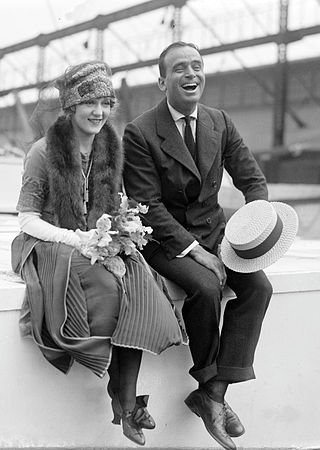
Western fashion in the 1920s underwent a modernization. Women's fashion continued to evolve from the restrictions of gender roles and traditional styles of the Victorian era. Women wore looser clothing which revealed more of the arms and legs, that had begun at least a decade prior with the rising of hemlines to the ankle and the movement from the S-bend corset to the columnar silhouette of the 1910s. Men also began to wear less formal daily attire and athletic clothing or 'Sportswear' became a part of mainstream fashion for the first time.
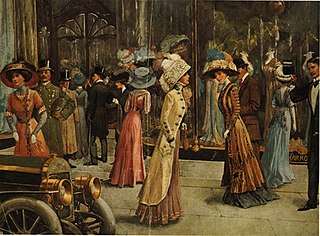
Fashion in the period 1900–1909 in the Western world continued the severe, long and elegant lines of the late 1890s. Tall, stiff collars characterize the period, as do women's broad hats and full "Gibson Girl" hairstyles. A new, columnar silhouette introduced by the couturiers of Paris late in the decade signaled the approaching abandonment of the corset as an indispensable garment.

A cheerleading uniform is a standardized outfit worn by cheerleaders during games and other events. These uniforms typically include the official colors and mascots of the school or team and are designed to make the wearer appear physically attractive. Early cheerleading outfits had pants or long dresses, but as cheerleading stunts became more complex, cheerleader uniforms have adapted to allow better range of motion.

An A-line skirt is a skirt that is fitted at the hips and gradually widens towards the hem, giving the impression of the shape of a capital letter A. The term is also used to describe dresses and coats with a similar shape.
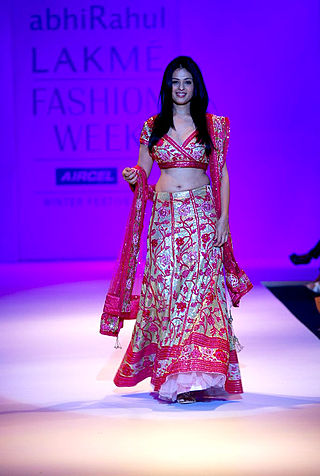
The lehenga, lehnga or langa or लेहंगा is a form of ankle-length skirt from the Indian subcontinent. Different patterns and styles of traditional embroidery are used to decorate lehenga. Gota patti embroidery is often used for festivals and weddings. The lehenga, also known as the ghagra, is a traditional Indian garment that became popular in the 16th century, mainly in India, Bangladesh and Pakistan. The lehenga became a favorite attire for Mughal women of all ages and classes due to its royal appeal and convenience The lehenga is sometimes worn as the lower portion of a gagra choli or langa voni. Ghagra in Hindi, was also used to refer to the half slip or petticoat, a skirt worn as an undergarment below the sari.

Twelfth century European fashion was simple in cut and differed only in details from the clothing of the preceding centuries, starting to become tighter and more similar for men and women as the century went on, which would continue in the 13th century. Men wore knee-length tunics for most activities, and men of the upper classes wore long tunics, with hose and mantle or cloaks. Women wore long tunics or gowns. A close fit to the body, full skirts, and long flaring sleeves were characteristic of upper-class fashion for both men and women.

The jellabiya, also jalabiya, galabeya or jalamia is a loose-fitting, traditional garment from the Nile Valley. Today, it is associated with farmers living in Egypt and comes in rich color varieties. The garment is also worn in Sudan, but has other textures and is usually white, as well as some communities from Eritrea and Ethiopia. The colorful Egyptian style is used by both men and women.
Mamianqun, is a type of traditional Chinese skirt. It is also known as mamianzhequn, but is sometimes simply referred as 'apron', a generic term in English to refer to any Chinese-style skirt, or 'paired apron' in English although they are not aprons as defined in the dictionary. The Mamianqun is a type of qun a traditional Chinese skirt worn by the Han Chinese women as a lower garment item in Hanfu and is one of the main representative styles of ancient Chinese-style skirts. It originated in the Song and Liao dynasties and became popular due to its functionality and its aesthetics style. It continued to be worn in the Yuan, Ming, and Qing dynasties where it was a typical style of skirt for women and was favoured for its unique aesthetic style and functionality. Following the fall of the Qing dynasty, the mamianqun continued to be worn in the Republic of China, and only disappeared in the 1920s and 1930s following the increased popularity of the cheongsam. As a type of xifu, Chinese opera costumes, the mamianqun maintains its long tradition and continues to be worn nowadays. In the 21st century, the mamianqun regained popularity with the emergence of the Hanfu movement. The mamianqun has experienced various fashion changes throughout history. It was typically paired with ku, Chinese trousers and Chinese jackets, typically either the ao or gua.